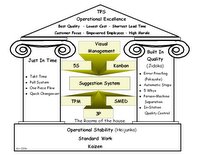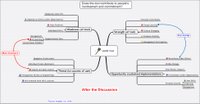Tuesday, January 31, 2006
Teleconference 31JAN2006
Phone call was held tonight. The meeting notes in map/pdf form are here. If you have MindManager software, the original map is here.
Discussion centered around:
Do workers like or dislike assessments? and
Why do they focus on numbers for org assessments?
If you would like to join these calls in the future, typically every Tuesday evening, the details are here.
On February 14th we are going to use a web meeting tool, along with the conference call. We will be discussing the S-W-O-T points of the Myers-Briggs tool.
Monday, January 30, 2006
TPS House
I'm probably not as up on LEAN as other people on the call. Since Juergen has been referring to the Toyota Production System (TPS) House, I figured I should find a reference. Plenty of those available.

I created a composit from multiple references. Some of those were:
- EMS Consulting Group
- Gemba Group
- A research report on LEAN Ship building
- and, Juergen had a presentation last November.
Tuesday, January 24, 2006
List of Tools
During the call we started to list various "tools" for LEAN. I had mentioned that I had started to surf the web looking for various lists and descriptions. My current very incomplete list can be found here.
I will be adding to it in the future.
Assessment Tools
Toward the end of the call we began to compile a list of tools for assessment.
This is not a complete list, but is a start. Feel free to add your favorite assessment tool information in the comments.
- Myers-Briggs
- DISC
- Toyota Hiring Assessment DDI
- Denison Organizational Culture Survey DOCS
- McKinsey 7-S Framework
- MIT VALUE self-assessment
- Structogram
- AutoZone modified version of a Ford vendor assessment
I couldn't find a good description of Structograms. Most of the sites were either non-English, or programming sites. Structograms are used for software design.
I did find an interesting site of on-line personality tests like Myers-Briggs assessments.
Update: It appears to me that we may be mixing apples and oranges. Some of these tools are targeting individuals, i.e. potential team members with Myers-Briggs. A few of the tools are more meaningful to assess organizational readiness, AutoZone's supplier assessment probably falls into this category.
Update II: Chuck Yorke sent us a link (I've added a comment) but wanted the reader to know about "Denison" as a cultural assessment tool.
Update III: David Csokasy sent along a better description for the Myers-Briggs Tool. The link has been updated (31JAN06).
Conference Call 24JAN2006
Phone call was held tonight. The meeting notes in map/pdf form are here. If you have MindManager software, the original map is here.
Discussion centered around:
What tools are in the LEAN toolbox? and
How does AutoZone do their assessments?
If you would like to join these calls in the future, typically every Tuesday evening, the details are here.
Culture Assessment Tools
A cultural assessment might consist of a “questionnaire approach” plus a “Genchi-Genbutsu” (go and see for yourself) approach where you just observe people and situations. Additionally top management is seeking close contact to the Gemba (place were action takes place).
Earlier we learned that Toyota is using a very advanced recruiting methodology that might take up to two (2) years – form first contact of hiring. A significant part of this assessment is most likely the personality evaluation of a candidate.
I wonder if Toyota is using any cultural assessment tools (questionnaire or observation) in their daily operation or during their periodical employee evaluation.
I would very much welcome any comment that might help clarifying this issue.
Thank you,
Regards,
Juergen Boenisch
Sunday, January 22, 2006
Discussion Topic
On last week's call, part of the discussion was about an assessment tool. This got me thinking about measurements in general.
What has your experience been with Dashboards and Metrics? Similar post on the LEAN Tool & Die Making blog.
I recall in the 80's that Quality Circles and measurement charts were the rage. I'm not unique in observing that a number of the measurements were easy to measure but not particularly significant.
How do you pick a metric to post and track?
(Here is a chance to use the comments.)
Tuesday, January 17, 2006
Teleconference 17JAN2006
Phone call was held tonight. The meeting notes in map/pdf form are here. If you have MindManager software, the original map is here.
Discussion centered around:
"How can two similar companies, same basic classroom session,
have two drastically different results?"
If you would like to join these calls in the future, typically every Tuesday evening, the details are here.
Friday, January 13, 2006
Comments About Comments
I added a comment on the 2006 Planning Session, but decided to pratice what I preach. If I'm right, you should hit this link, now. I'll be here when you get back.
All these comments are interesting and useful. On the other hand, the summary or meat of the argument would make an excellent post and then the details could be a link. So doing, a visitor/reader of the blog can get the gist of the discussion. The really interested reader can get to the detailed expositions by drilling down via the link.
Don't get me wrong, the comments section provides an excellent running commentary on the original topic. It also can drift off into some great off topic stuff, but... , the casual or first time reader usually scans the blog, not the comments. That casual reader would miss the impact of your detailed comments.
Karen has structured it so most of the tech group can "post" AND "comment."
[Sermon ON]
This makes a blog a different structure and more flexible than a discussion thread. The game is to link. Links are the equivalent of attachments to emails. The difference is that your server may fire up an html page or download the pdf/doc. The page visitor can decide how much detail they need.
When you "post" it provides both an abstract and a hook to get the reader to look further.
[Sermon OFF]
BTW; My blogger ID is Piquero, most of your know me as Igor, and officially I'm Bob Rowen.
Thursday, January 12, 2006
Continued Idea
After last night's post I started doodling about what a SWOT would look like on a Mind Map. A simple format could have the branches contain pre-agreed categories under the major topics (S-W-O-T). Something like this:(click on it to enlarge)

The discussion would consist of assigning a value to relevant categories, the same as setting priorities in an action list. The discussion would be structured, fast, and somewhat consistent from one tool to the next. The resulting map would look something like this:(click to enlarge)

A more robust discussion would brainstorm categories or be more expansive about categories. The capability of capturing the discussion that explains "why" we reached a conclusion or value could also be captured.
The "tool list" could then be augmented with a link to the completed map.
Comments about the "pre-built" categories would be useful.
Wednesday, January 11, 2006
Some Phone Call Ideas
A thought occured to me last night as I went through my notes from the Tuesday conference call.
One proposal involved categorizing tools in terms of failure modes and importance of human interaction. I didn't ask at the time; is there a commonly recognized list of tools (and techniques)?
If so, then we might do the following:
- Post the list
- Pick a tool and find a good web description of it
- Announce in advance the link and the night we will discuss it
- Provide enough lead time for people to read the description/article
- On the appointed evening, spend time doing a SWOT-like assessment of the tool. But emphasize the human dimensions of the tool.
- Publish the discussion here for additional comment
This wouldn't have to take the full phone call. A structured 20-25 minute discussion would suffice. And it probably could be every 2 or 3 weeks. We may have to write the article or description first (though I assume we can excerpt some of the literature if it isn't already electronic).
Friday, January 06, 2006
Tech Group Strategy - focusing questions
Now brainstorm on the following questions. Do not draw conclusions yet. It's best not to refer to the strategy statement for this exercise. It is OK for the same answer to appear under more than one question.
Knowledge
What does the customer want to know? Examples: How to participate in tech group; how to deal with resistance to lean?
What do you want the customer to know? Examples: "Respect for people" is an all-important element of lean; How to participate in tech group.
Action
What does the customer want to do? Examples: Meet experts; Confront the boss.
What do you want the customer to do? Examples: Go to conference; join the conference call.
This refers to what the customer "wants to know/do" rather than "needs to know/do" because we have a natural tendency to think of "need" as something the person should do, in our opinion. You want to think of the person's own motivations and emotions that drive their behavior.
You don't have to do formal research right now, although you could plan some for the future. You know this customer, you work right next to him/her, or he/she manages your company, or you met this person at a function, and so on. You may be this person yourself.
When you get to the "we want the customer to know/do" you are in the realm of the "should" and the project or product you want to develop.
Once you get some answers to the questions, I can take you through a prioritization process.